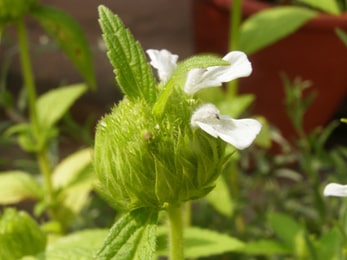Dronapushpi (Leucas cephalotes) – Properties, Benefits & Dosage

Description of Plant
Dronapushpi (Leucas cephalotes) is an annual, branched, erect stout plant which grows with a height of about15-60 cm. Leaves are narrow, ovate, and Yellowish-green in color and about 3-9cm long, 1-2.5cm wide, having, pungent taste; Roots are smooth, cylindrical, zigzag, along with various wiry, fine rootlets with variable size, fracture, fibrous and taste is Stem is quadrangular with rough, hairy surface and having Light greenish-yellow color whose taste is slightly bitter. Flowers are white, small sessile, in dense axillary whorls. Fruits: Schizocarpic carcerule, nutlets 3mm smooth, brown.
General Description
Dronapushpi (Leucas cephalotes) is a famous Ayurvedic medicinal herb that grows as a weed in India and many South East Asian countries. It is cultivated in fields as a weed, especially after a period of rain. It is collected for use as a leafy vegetable in rural areas as well as for its medicinal uses. The traditional use of this herb is for treating snake bite, cough, fever scorpion stings, etc. It is also used in treating liver disorders, jaundice, asthma, cough cold etc. Therapeutically, it has Properties of antimicrobial, insecticidal, fever reducing, larvicidal and inflammation reducing herb.
Chemical composition of this herb consists of Laballenic acid, B- Sitosterol and its glycoside, oleanolic acid, 7-oxositosterol, 7-oxostigmasterol, 7alpha-hydroxy stigmasterol, stigmasterol, 5-hydroxy-7,4′-dimethoxy flavone, pillion, gonzalitosin I, Tricin, cosmosin, apigenin-7-O-beta-D-(6-O-p-coumaryl) glucopyranoside, anisofolin A and luteolin.
Classification of Leucas cephalotes
- Kingdom: Plantae, Plant
- Subkingdom: Tracheobionta, Vascular plant
- Super division: Spermatophyta, Seed plant
- Division: Angiosperma
- Class: Dicotyledonae
- Sub-class: Gamopetalae
- Series: Bicarpellatae
- Order: Tubiflorae
- Family: Labiatae
- Genus: Leucas
- Species: Leucas Cephalotes
Related species that is known as Dronapushpi is Leucas aspera.
Habitat of Leucas cephalotes
This herb is commonly found throughout India and China. All through India, it is especially found as a weed in cultivated lands, road sides and on waste lands at an altitude of 30-100 m high and rising up to 1,800 meters in the Himalayas. Leucas cephalotes is as well found in the plains of Bangladesh, South-East Asian countries, Mauritius, java and Philippines, China, Malaysia. It is also commonly found in Nepal, Pakistan, and in East Asia it found at an elevation of 1,700 m in Afghanistan to Western China.
Names of Leucas cephalotes in Different Language
- English Name – Spider wort
- Hindi Name – Guma
- Telugu Name – Tummi, Peddatumani
- Bengali Name – Dandakalas, Halaksa, Ghalghase
- Marathi Name – Tubari, Tumba
- Gujarati Name – Kubo
- Punjabi Name – Gomobati, Gumma
- Tamil Name – Tumbari
- Kannada Name – Tumbe, Tumbe hoovu, Tumbe gida
- Malayalam Name – Tumba, Tumba Poovu
- Sanskrit Name – Katumba
- Oriya Name – Gaisha
- Assamese Name – Dronaphool
Ayurvedic Properties
| Hindi / Sanskrit | English | ||
| Rasa | Katu | Taste | Pungent |
| Guna | Guru, Rooksha | Physical Property | Heavy, Dry |
| Virya | Ushna | Potency | Hot |
| Vipaka | Madhura, Katu | Metabolic Property (After Digestion) | Sweet, Pungent |
Ancient Verse about Leucas cephalotes

The Bhavprakash nighantu edition of 1998 verse – 272-273, page no-463-464.
The name and properties of Guma are Drona, Dronapushpi and Phalepuspa. The Guma is heavy, dryand hot in potency. It is piercing in nature so is effective for obstructive jaundice, inflammation and bronchial asthma.
References:-
The Bhavprakash nighantu with elaborated Hindi commentary by Padmashri prof. K.C. Chunekar, edited by Dr. G.S. Pandey: edition of 1998; verse – 272-273, page no-463-464.
Practical Uses of Leucas cephalotes
Dronapushpi can balance Kapha and Vata.
This herbal Plant is found to be anthelmintic, antiseptic, insecticidal, anti- scabies, anticoagulant, antipyretic, stimulant, expectorant, diaphoretic, insecticidal, emmenagogue, antioxidant, anti-inflammatory and anti-diabetic. Cardiac depressant, hypotensive and exhibits potent anti-filarial activity against adult worms and the microfilaria.
- It is useful in skin diseases like itching, patchy skin, psoriasis, scabies etc. The paste of leaves is applied externally at the affected body areas.
- Juice of this plant has been reported to act as an ant-bilious herbal therapy for jaundice.
- Beneficial in case of worm infestation, infected wounds.
- Helps in reducing swelling because of its anti-inflammatory property.
- Relieves asthma, cough and cold.
- This herb is good to improve taste as well relieves anorexia.
- The decoction of the herb as wash liquid is useful in ulcers and is also applied externally to poisonous insect bites.
- Good to relieve indigestion, low digestive strength.
- Suitable in case of amenorrhea, oligomenorrhea.
- It is scraping in nature which makes it capable to scrape the sputum out.
- Dronapushpi has been known to show positive test in filariasis.
- The whole plant powder is used to cure epileptic convulsions and cerebral function disorders.
- It is also useful in colic, dyspepsia arthralgia.
- Dronapushpi herb has capacity to flush out the toxins from body.
Part Used
- Whole Plant,
- Leaves,
- Flowers
Dosage
- Fresh juice: 5 -10 ml juice
- Powder for decoction: 1–3g
Caution
- Excess use or over-dosage of this herb may lead to increased burning sensation.
- Avoid it in pregnancy. Recommended to use this herb under proper medical guidance.



